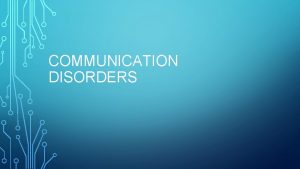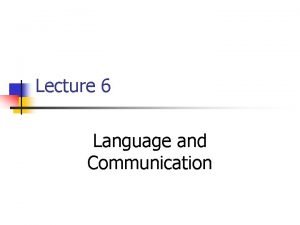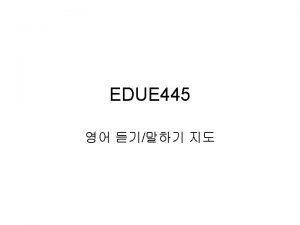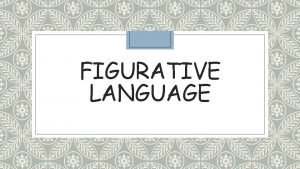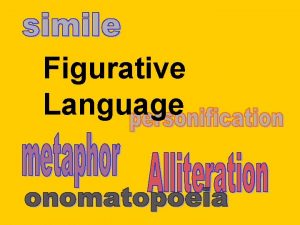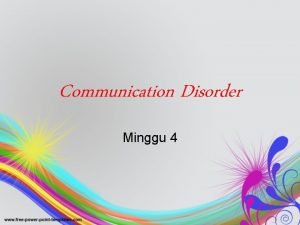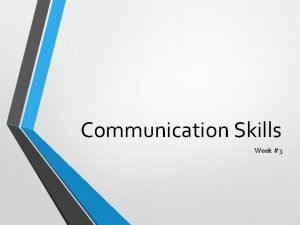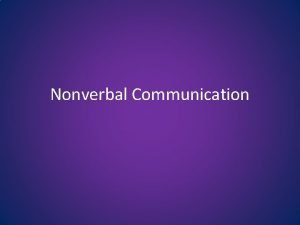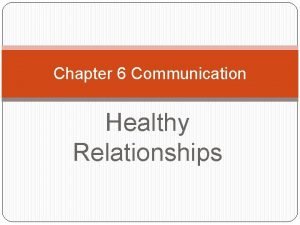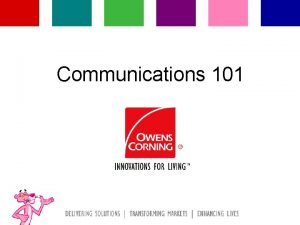LANGUAGE COMMUNICATION The aim of this tutorial is









































- Slides: 41

LANGUAGE & COMMUNICATION The aim of this tutorial is to help you to understand the relationships among language, communication, and critical thinking.

2 In what ways are the man and the woman in this photo engaging in communication? © 2012, The Mc. Graw-Hill Companies, Inc. All Rights Reserved.

Good communication skills are an essential part of critical thinking 3 Communication skills enable effective critical thinking and decision-making. Effective communication involves several related skills: Keeping avenues of communication open Communicating with others clearly and accurately Taking care with word use Developing awareness of your own and others’ language use People’s communication styles © 2012, The Mc. Graw-Hill Companies, Inc. All Rights Reserved.

Language is the key 4 Language is a system of communication with arbitrary symbols, whether spoken, written, or nonverbal. By creating a shared reality among people, language is the primary means of transmitting cultural concepts and traditions, including critical thinking skills. © 2012, The Mc. Graw-Hill Companies, Inc. All Rights Reserved.

5 Languages of the world © 2012, The Mc. Graw-Hill Companies, Inc. All Rights Reserved.

6 Animal language © 2012, The Mc. Graw-Hill Companies, Inc. All Rights Reserved.

Functions of language 7 Language has one basic function: the communication of information about ourselves and the world. This is informative language. Other functions of language include: Directive language—used to direct or influence actions Expressive language—communicates feelings; used to generate emotive impact Ceremonial language—used in prescribed formal circumstances Most languages serve multiple functions. © 2012, The Mc. Graw-Hill Companies, Inc. All Rights Reserved.

Language enables effective critical thinking 8 Using language effectively to convey information, provide direction, and express feelings is essential for individual and collaborative critical thinking. It is important to understand that while language greatly enriches our communication of ideas and feelings, it also can contribute to ambiguity and misunderstanding. Intellectual curiosity and awareness of other people’s language use are two critical thinking skills that can make us less susceptible to misunderstanding and manipulation. © 2012, The Mc. Graw-Hill Companies, Inc. All Rights Reserved.

9 Not all language is verbal © 2012, The Mc. Graw-Hill Companies, Inc. All Rights Reserved.

Nonverbal language 10 Nonverbal cues, such as body language and vocal tone, often help us interpret verbal communication. Nonverbal cues are commonly used to reinforce verbal communication. Images, such as artwork or photographs, are also means of communicating ideas and feelings. © 2012, The Mc. Graw-Hill Companies, Inc. All Rights Reserved.

11 Amanda Knox © 2012, The Mc. Graw-Hill Companies, Inc. All Rights Reserved.

Language is a cultural construct 12 Good critical thinkers realize that word choices and nonverbal cues significantly influence how verbal communication is interpreted—or misinterpreted. The following approaches greatly assist effective communication: Communicate clearly, and be conscious of language’s complexity and flexibility Be willing to ask people for clarification if you are uncertain of their meaning © 2012, The Mc. Graw-Hill Companies, Inc. All Rights Reserved.

Same word, different meanings 13 Like all languages, the English language is in constant flux. This dynamic state means that word meanings change constantly as words move in and out of use. In order to communicate accurately and clearly, it is important to understand the difference between the denotative and connotative meanings of words. © 2012, The Mc. Graw-Hill Companies, Inc. All Rights Reserved.

Denotative and connotative meanings 14 All words have both denotative and connotative meanings. The denotative meaning of a word or phrase expresses the properties of the object, being, or event the word is symbolizing; its dictionary definition. The connotative meaning of a word or phrase includes feelings and personal feelings based on past experiences and associations. This means a word’s connotative meaning may be in a dictionary listing, but also could be shared only among small groups. Stereotypes are a good example. © 2012, The Mc. Graw-Hill Companies, Inc. All Rights Reserved.

15 The denotative meaning of the word dog is a domesticated member of the family Canis familiaris. © 2012, The Mc. Graw-Hill Companies, Inc. All Rights Reserved.

Types of word definitions 16 There are four major types of word definitions: Stipulative definitions are definitions given to new words or terms, or are new definitions of existing words. Lexical definitions are the commonly used dictionary definitions for words or terms. Precising definitions are used to reduce vagueness. They are split into two subsets: (a) theoretical definitions, used to provide theory, and (b) operational definitions, used to provide standards in data collection. Persuasive definitions are used to influence or persuade others. © 2012, The Mc. Graw-Hill Companies, Inc. All Rights Reserved.

17 Lexical definitions of a word may vary from country to country—homely, for example. © 2012, The Mc. Graw-Hill Companies, Inc. All Rights Reserved.

18 Body mass index (BMI)—an example of operational definition © 2012, The Mc. Graw-Hill Companies, Inc. All Rights Reserved.

Evaluating definitions 19 Five criteria are useful in evaluating word definitions: Good definitions are neither too broad nor too narrow. Good definitions state the essential attributes of the term being defined. Good definitions are not circular. Good definitions avoid obscure and figurative language. Good definitions avoid emotive language. © 2012, The Mc. Graw-Hill Companies, Inc. All Rights Reserved.

20 A definition of penguin as “a bird that lives in Antarctica” is both too broad and too narrow. © 2012, The Mc. Graw-Hill Companies, Inc. All Rights Reserved.

Communication styles 21 Good critical thinkers are aware that there are differences in individual as well as in group communication styles. Understanding our styles and those of others facilitates good communication in relationships and critical thinking skills. © 2012, The Mc. Graw-Hill Companies, Inc. All Rights Reserved.

Communication styles 22 There are four basic types of communication style: Assertive communicators clearly and respectfully communicate their own needs and strive for mutually satisfactory solutions. Aggressive communicators attempt to get their own way by controlling other people through manipulation and control tactics. Passive communicators avoid confrontation and are compliant, often putting their needs after those of others. Passive-aggressive communicators avoid direct confrontation but use devious means to get their own way. © 2012, The Mc. Graw-Hill Companies, Inc. All Rights Reserved.

Communication styles: other factors 23 Other factors may influence communication styles. These factors include, but are not limited to Gender Ethnicity Culture Dress © 2012, The Mc. Graw-Hill Companies, Inc. All Rights Reserved.

24 Clothing communicates information about a person and his or her cultural beliefs. © 2012, The Mc. Graw-Hill Companies, Inc. All Rights Reserved.

25 International diplomacy and nonverbal communication © 2012, The Mc. Graw-Hill Companies, Inc. All Rights Reserved.

Language as manipulation 26 Language can be used to deceive as well as to inform. Typically, manipulation occurs through the use of three devices: emotive language, rhetorical devices, and/or deliberate deception. © 2012, The Mc. Graw-Hill Companies, Inc. All Rights Reserved.

Emotive language 27 Emotive language: Emotive language is used to elicit a certain emotional impact, either positive or negative. When a factual issue arises, emotive language can slant the truth and obscure our critical thinking abilities. It is particularly dangerous when used to cover weak arguments, for marketing purposes, or when it masquerades as news in the media. © 2012, The Mc. Graw-Hill Companies, Inc. All Rights Reserved.

28 News publications often rely on sensationalist headlines. © 2012, The Mc. Graw-Hill Companies, Inc. All Rights Reserved.

Rhetorical devices 29 Rhetorical devices, like emotive language, use psychological persuasion rather than reason to persuade others. Common rhetorical devices include Euphemisms Dysphemisms Sarcasm Hyperbole © 2012, The Mc. Graw-Hill Companies, Inc. All Rights Reserved.

30 Politicians are notorious for their manipulative use of language. © 2012, The Mc. Graw-Hill Companies, Inc. All Rights Reserved.

Euphemisms and dysphemisms 31 Euphemisms replace negative terms with neutral or positive terms in order to conceal or sugar-coat the truth. Dysphemisms, in contrast to euphemisms, use negative terms to produce negative effects. They are often used to win over one group while at the same time alienating others. © 2012, The Mc. Graw-Hill Companies, Inc. All Rights Reserved.

Sarcasm and hyperbole 32 Sarcasm involves the use of ridicule, insults, taunting, and/or caustic irony. Like other rhetorical devices, it is used to deflect critical analysis and to encourage feelings of disapproval toward the subject. Hyperbole is a device that uses exaggeration or overstatement to distort the facts. As good critical thinkers, we must be able to recognize and resist these rhetorical devices. © 2012, The Mc. Graw-Hill Companies, Inc. All Rights Reserved.

33 George Orwell’s Nineteen Eighty-Four © 2012, The Mc. Graw-Hill Companies, Inc. All Rights Reserved.

Deception and lying 34 Although rhetorical devices may involve deception, the deception is not always deliberate. A lie, on the other hand, is a deliberate attempt to mislead without prior consent. Lies can Damage trust Derail honest communication © 2012, The Mc. Graw-Hill Companies, Inc. All Rights Reserved.

Detecting lies 35 As good critical thinkers, we must be able to detect, recognize, and challenge lies. Always cross-verify and check information Be aware of nonverbal cues of lying, such as less physical movement and blinking, changes in voice tone and pitch, errors in storytelling, etc. © 2012, The Mc. Graw-Hill Companies, Inc. All Rights Reserved.

36 Facial expressions can disclose a wealth of information. © 2012, The Mc. Graw-Hill Companies, Inc. All Rights Reserved.

37 Polygraph © 2012, The Mc. Graw-Hill Companies, Inc. All Rights Reserved.

Hot or Not? 38 Is lying for the greater good ever justified? © 2012, The Mc. Graw-Hill Companies, Inc. All Rights Reserved.

Conclusions 39 Language is a form of symbolic communication that allows us to organize, express, and critically analyze our experiences. It shapes our understanding of reality and of ourselves. Good communication skills are vital in critical thinking. As good critical thinkers, we need to clearly define terms, be mindful of our communication styles and those of others, and be aware of the manipulative and deceptive powers of language. © 2012, The Mc. Graw-Hill Companies, Inc. All Rights Reserved.

40 Sally Ride © 2012, The Mc. Graw-Hill Companies, Inc. All Rights Reserved.

41 Perspectives on free-speech zones on college campuses © 2012, The Mc. Graw-Hill Companies, Inc. All Rights Reserved.
 Hình ảnh bộ gõ cơ thể búng tay
Hình ảnh bộ gõ cơ thể búng tay Ng-html
Ng-html Bổ thể
Bổ thể Tỉ lệ cơ thể trẻ em
Tỉ lệ cơ thể trẻ em Voi kéo gỗ như thế nào
Voi kéo gỗ như thế nào Tư thế worm breton
Tư thế worm breton Hát lên người ơi
Hát lên người ơi Môn thể thao bắt đầu bằng chữ đua
Môn thể thao bắt đầu bằng chữ đua Thế nào là hệ số cao nhất
Thế nào là hệ số cao nhất Các châu lục và đại dương trên thế giới
Các châu lục và đại dương trên thế giới Cong thức tính động năng
Cong thức tính động năng Trời xanh đây là của chúng ta thể thơ
Trời xanh đây là của chúng ta thể thơ Cách giải mật thư tọa độ
Cách giải mật thư tọa độ Phép trừ bù
Phép trừ bù độ dài liên kết
độ dài liên kết Các châu lục và đại dương trên thế giới
Các châu lục và đại dương trên thế giới Thể thơ truyền thống
Thể thơ truyền thống Quá trình desamine hóa có thể tạo ra
Quá trình desamine hóa có thể tạo ra Một số thể thơ truyền thống
Một số thể thơ truyền thống Bàn tay mà dây bẩn
Bàn tay mà dây bẩn Vẽ hình chiếu vuông góc của vật thể sau
Vẽ hình chiếu vuông góc của vật thể sau Nguyên nhân của sự mỏi cơ sinh 8
Nguyên nhân của sự mỏi cơ sinh 8 đặc điểm cơ thể của người tối cổ
đặc điểm cơ thể của người tối cổ V cc
V cc Vẽ hình chiếu đứng bằng cạnh của vật thể
Vẽ hình chiếu đứng bằng cạnh của vật thể Phối cảnh
Phối cảnh Thẻ vin
Thẻ vin đại từ thay thế
đại từ thay thế điện thế nghỉ
điện thế nghỉ Tư thế ngồi viết
Tư thế ngồi viết Diễn thế sinh thái là
Diễn thế sinh thái là Dạng đột biến một nhiễm là
Dạng đột biến một nhiễm là Bảng số nguyên tố
Bảng số nguyên tố Tư thế ngồi viết
Tư thế ngồi viết Lời thề hippocrates
Lời thề hippocrates Thiếu nhi thế giới liên hoan
Thiếu nhi thế giới liên hoan ưu thế lai là gì
ưu thế lai là gì Hổ đẻ mỗi lứa mấy con
Hổ đẻ mỗi lứa mấy con Khi nào hổ con có thể sống độc lập
Khi nào hổ con có thể sống độc lập Hệ hô hấp
Hệ hô hấp Từ ngữ thể hiện lòng nhân hậu
Từ ngữ thể hiện lòng nhân hậu Thế nào là mạng điện lắp đặt kiểu nổi
Thế nào là mạng điện lắp đặt kiểu nổi














































